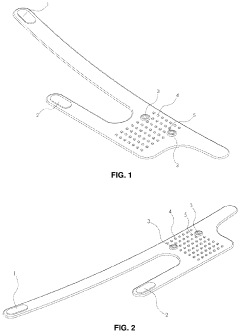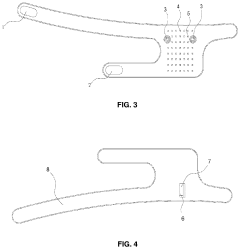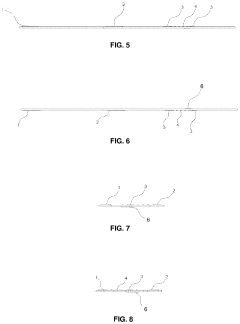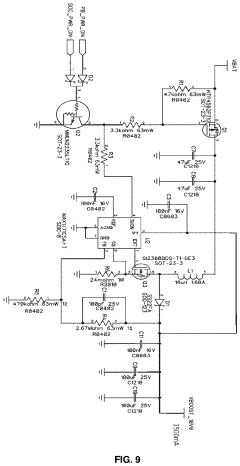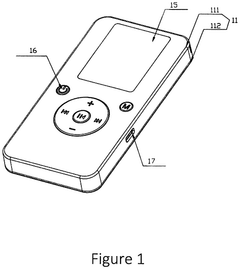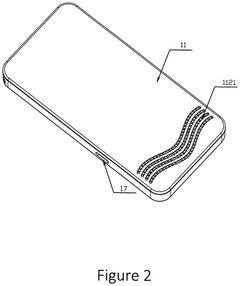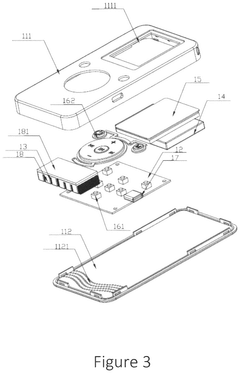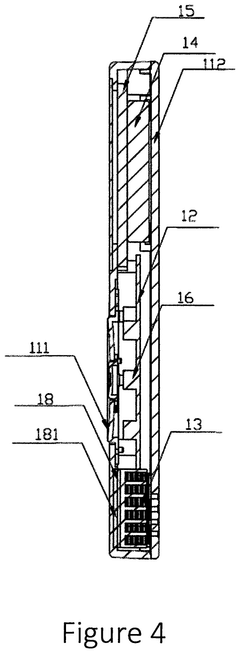Innovations in Portable PEMF Therapy Equipment and Use Cases
AUG 11, 20259 MIN READ
Generate Your Research Report Instantly with AI Agent
Patsnap Eureka helps you evaluate technical feasibility & market potential.
PEMF Technology Evolution
Pulsed Electromagnetic Field (PEMF) therapy has undergone significant evolution since its inception in the mid-20th century. Initially developed for bone healing, PEMF technology has expanded its applications to various medical and wellness fields. The early devices were large, stationary units primarily used in clinical settings. As research progressed, the understanding of optimal frequencies and intensities for different conditions improved, leading to more targeted and effective treatments.
The 1970s and 1980s saw the first FDA approvals for PEMF devices in bone healing applications. This period marked a crucial milestone in the technology's acceptance within mainstream medicine. Concurrently, researchers began exploring PEMF's potential in pain management and tissue repair, broadening its therapeutic scope.
The 1990s and early 2000s witnessed a shift towards miniaturization and portability. Advances in electronics and battery technology enabled the development of smaller, more user-friendly devices. This transition from clinical to home-use equipment significantly expanded PEMF's accessibility and market potential.
In recent years, the focus has been on enhancing precision and customization. Modern PEMF devices incorporate sophisticated control systems that allow for fine-tuning of frequency, intensity, and waveform patterns. This customization enables more personalized treatment protocols, potentially improving efficacy across a wider range of conditions.
The integration of smart technology has been a game-changer in the latest generation of portable PEMF devices. Bluetooth connectivity, smartphone apps, and cloud-based data analysis have transformed these devices into comprehensive health management tools. Users can now track their therapy sessions, adjust settings remotely, and share data with healthcare providers, fostering a more collaborative approach to treatment.
Innovations in coil design and materials have also played a crucial role in enhancing portability and effectiveness. Flexible, lightweight coils that can conform to different body parts have replaced bulky, rigid designs. Additionally, advancements in battery technology have extended device operation times, making them more practical for continuous use.
The evolution of PEMF technology has not been limited to hardware improvements. There has been a parallel development in treatment protocols and application methods. Research has led to a better understanding of how different tissues respond to varying electromagnetic fields, allowing for more targeted therapies. This knowledge has been instrumental in expanding PEMF's use cases beyond its traditional applications in orthopedics to areas such as neurology, cardiology, and mental health.
The 1970s and 1980s saw the first FDA approvals for PEMF devices in bone healing applications. This period marked a crucial milestone in the technology's acceptance within mainstream medicine. Concurrently, researchers began exploring PEMF's potential in pain management and tissue repair, broadening its therapeutic scope.
The 1990s and early 2000s witnessed a shift towards miniaturization and portability. Advances in electronics and battery technology enabled the development of smaller, more user-friendly devices. This transition from clinical to home-use equipment significantly expanded PEMF's accessibility and market potential.
In recent years, the focus has been on enhancing precision and customization. Modern PEMF devices incorporate sophisticated control systems that allow for fine-tuning of frequency, intensity, and waveform patterns. This customization enables more personalized treatment protocols, potentially improving efficacy across a wider range of conditions.
The integration of smart technology has been a game-changer in the latest generation of portable PEMF devices. Bluetooth connectivity, smartphone apps, and cloud-based data analysis have transformed these devices into comprehensive health management tools. Users can now track their therapy sessions, adjust settings remotely, and share data with healthcare providers, fostering a more collaborative approach to treatment.
Innovations in coil design and materials have also played a crucial role in enhancing portability and effectiveness. Flexible, lightweight coils that can conform to different body parts have replaced bulky, rigid designs. Additionally, advancements in battery technology have extended device operation times, making them more practical for continuous use.
The evolution of PEMF technology has not been limited to hardware improvements. There has been a parallel development in treatment protocols and application methods. Research has led to a better understanding of how different tissues respond to varying electromagnetic fields, allowing for more targeted therapies. This knowledge has been instrumental in expanding PEMF's use cases beyond its traditional applications in orthopedics to areas such as neurology, cardiology, and mental health.
Market Demand Analysis
The market demand for portable Pulsed Electromagnetic Field (PEMF) therapy equipment has been steadily increasing in recent years, driven by growing awareness of its potential health benefits and the rising preference for non-invasive treatment options. This technology, which uses electromagnetic fields to stimulate cellular repair and reduce inflammation, has found applications in various medical fields, including orthopedics, neurology, and sports medicine.
The global PEMF therapy devices market is experiencing significant growth, with a particular emphasis on portable and home-use devices. This trend is fueled by the increasing prevalence of chronic pain conditions, sports injuries, and the aging population seeking alternative pain management solutions. The COVID-19 pandemic has further accelerated the demand for at-home medical devices, including portable PEMF equipment, as patients seek ways to manage their health conditions without frequent hospital visits.
In the sports and fitness sector, portable PEMF devices are gaining traction among athletes and fitness enthusiasts for faster recovery and improved performance. Professional sports teams and rehabilitation centers are incorporating these devices into their treatment protocols, creating a substantial market segment for high-end, professional-grade portable PEMF equipment.
The wellness and alternative medicine markets also contribute significantly to the demand for portable PEMF therapy devices. Consumers are increasingly looking for holistic approaches to health maintenance and stress reduction, driving the adoption of PEMF technology in spas, wellness centers, and personal use.
Geographically, North America and Europe lead the market for portable PEMF therapy equipment, owing to higher healthcare expenditure, greater awareness, and more favorable regulatory environments. However, emerging economies in Asia-Pacific and Latin America are showing rapid growth potential as healthcare infrastructure improves and disposable incomes rise.
The market is also seeing a shift towards more user-friendly, compact, and technologically advanced devices. Innovations in battery technology, allowing for longer operating times, and the integration of smart features such as mobile app connectivity and personalized treatment programs are becoming key differentiators in the competitive landscape.
Despite the positive market outlook, challenges remain. These include the need for more extensive clinical research to validate the efficacy of PEMF therapy across various conditions, regulatory hurdles in some regions, and the relatively high cost of advanced portable devices, which may limit adoption in price-sensitive markets.
The global PEMF therapy devices market is experiencing significant growth, with a particular emphasis on portable and home-use devices. This trend is fueled by the increasing prevalence of chronic pain conditions, sports injuries, and the aging population seeking alternative pain management solutions. The COVID-19 pandemic has further accelerated the demand for at-home medical devices, including portable PEMF equipment, as patients seek ways to manage their health conditions without frequent hospital visits.
In the sports and fitness sector, portable PEMF devices are gaining traction among athletes and fitness enthusiasts for faster recovery and improved performance. Professional sports teams and rehabilitation centers are incorporating these devices into their treatment protocols, creating a substantial market segment for high-end, professional-grade portable PEMF equipment.
The wellness and alternative medicine markets also contribute significantly to the demand for portable PEMF therapy devices. Consumers are increasingly looking for holistic approaches to health maintenance and stress reduction, driving the adoption of PEMF technology in spas, wellness centers, and personal use.
Geographically, North America and Europe lead the market for portable PEMF therapy equipment, owing to higher healthcare expenditure, greater awareness, and more favorable regulatory environments. However, emerging economies in Asia-Pacific and Latin America are showing rapid growth potential as healthcare infrastructure improves and disposable incomes rise.
The market is also seeing a shift towards more user-friendly, compact, and technologically advanced devices. Innovations in battery technology, allowing for longer operating times, and the integration of smart features such as mobile app connectivity and personalized treatment programs are becoming key differentiators in the competitive landscape.
Despite the positive market outlook, challenges remain. These include the need for more extensive clinical research to validate the efficacy of PEMF therapy across various conditions, regulatory hurdles in some regions, and the relatively high cost of advanced portable devices, which may limit adoption in price-sensitive markets.
Technical Challenges
Portable PEMF (Pulsed Electromagnetic Field) therapy equipment faces several technical challenges that hinder its widespread adoption and effectiveness. One of the primary obstacles is miniaturization while maintaining therapeutic efficacy. As devices become more compact for portability, there's a risk of compromising the strength and penetration depth of the electromagnetic fields, potentially reducing treatment effectiveness.
Power management presents another significant hurdle. Portable PEMF devices require substantial energy to generate effective electromagnetic fields, yet they must operate on battery power for extended periods. Balancing power consumption with battery life and device size remains a complex engineering challenge. Additionally, ensuring consistent field strength throughout the battery's discharge cycle is crucial for maintaining therapeutic benefits.
The development of flexible and conformable PEMF applicators poses a technical challenge. Creating pliable components that can adapt to various body contours while maintaining uniform field distribution is essential for effective treatment but requires advanced materials and manufacturing techniques. This challenge is particularly relevant for wearable PEMF devices designed for continuous use.
Precision in field generation and control is another critical area. Portable PEMF devices must accurately produce specific frequencies and waveforms tailored to different therapeutic needs. Achieving this level of precision in a compact, portable format demands sophisticated electronic design and signal processing capabilities.
Electromagnetic interference (EMI) mitigation is a significant concern, especially as PEMF devices become more prevalent in various environments. Ensuring that portable PEMF equipment doesn't interfere with other electronic devices, medical implants, or sensitive equipment is crucial for safety and regulatory compliance.
Durability and reliability present ongoing challenges, particularly for devices intended for frequent use or in diverse environments. Portable PEMF equipment must withstand physical stress, temperature variations, and potential exposure to moisture or dust while maintaining consistent performance.
User interface and ease of use pose additional technical hurdles. Designing intuitive controls and displays that allow users to select appropriate treatment parameters without professional guidance requires careful consideration of human factors and user experience design.
Lastly, the integration of smart features and connectivity presents both opportunities and challenges. Incorporating capabilities such as treatment tracking, personalized protocols, and remote monitoring can enhance the therapeutic value of portable PEMF devices. However, implementing these features securely and efficiently within the constraints of a portable form factor requires advanced software development and data management solutions.
Power management presents another significant hurdle. Portable PEMF devices require substantial energy to generate effective electromagnetic fields, yet they must operate on battery power for extended periods. Balancing power consumption with battery life and device size remains a complex engineering challenge. Additionally, ensuring consistent field strength throughout the battery's discharge cycle is crucial for maintaining therapeutic benefits.
The development of flexible and conformable PEMF applicators poses a technical challenge. Creating pliable components that can adapt to various body contours while maintaining uniform field distribution is essential for effective treatment but requires advanced materials and manufacturing techniques. This challenge is particularly relevant for wearable PEMF devices designed for continuous use.
Precision in field generation and control is another critical area. Portable PEMF devices must accurately produce specific frequencies and waveforms tailored to different therapeutic needs. Achieving this level of precision in a compact, portable format demands sophisticated electronic design and signal processing capabilities.
Electromagnetic interference (EMI) mitigation is a significant concern, especially as PEMF devices become more prevalent in various environments. Ensuring that portable PEMF equipment doesn't interfere with other electronic devices, medical implants, or sensitive equipment is crucial for safety and regulatory compliance.
Durability and reliability present ongoing challenges, particularly for devices intended for frequent use or in diverse environments. Portable PEMF equipment must withstand physical stress, temperature variations, and potential exposure to moisture or dust while maintaining consistent performance.
User interface and ease of use pose additional technical hurdles. Designing intuitive controls and displays that allow users to select appropriate treatment parameters without professional guidance requires careful consideration of human factors and user experience design.
Lastly, the integration of smart features and connectivity presents both opportunities and challenges. Incorporating capabilities such as treatment tracking, personalized protocols, and remote monitoring can enhance the therapeutic value of portable PEMF devices. However, implementing these features securely and efficiently within the constraints of a portable form factor requires advanced software development and data management solutions.
Current PEMF Solutions
01 Compact and lightweight design
Portable PEMF therapy equipment is designed to be compact and lightweight, allowing for easy transportation and use in various settings. The devices are often made with miniaturized components and ergonomic designs to enhance portability without compromising functionality.- Compact and lightweight design: Portable PEMF therapy equipment is designed to be compact and lightweight, allowing for easy transportation and use in various settings. The devices are often miniaturized and use advanced materials to reduce weight while maintaining functionality, making them ideal for on-the-go treatments.
- Battery-powered operation: Many portable PEMF devices are equipped with rechargeable batteries, enabling cordless operation and increased mobility. This feature allows users to receive treatment without being tethered to a power outlet, enhancing the equipment's portability and convenience.
- Wearable PEMF devices: Some portable PEMF therapy equipment is designed as wearable devices, such as belts, wraps, or patches. These wearable formats allow for hands-free operation and can be easily concealed under clothing, making them suitable for continuous use throughout the day.
- Modular and customizable systems: Portable PEMF therapy equipment often features modular designs, allowing users to customize the device for specific body areas or treatment needs. This modularity enhances portability by enabling users to carry only the necessary components for their particular treatment requirements.
- Smart device integration: Many modern portable PEMF therapy devices incorporate smart technology, allowing them to be controlled and monitored via smartphones or tablets. This integration enhances portability by reducing the need for separate control units and enabling users to manage their treatments remotely.
02 Battery-powered operation
Many portable PEMF devices are equipped with rechargeable batteries or use standard batteries, enabling cordless operation and increased mobility. This feature allows users to receive therapy without being tethered to a power outlet, making the equipment suitable for use during travel or outdoor activities.Expand Specific Solutions03 Wearable PEMF devices
Advancements in PEMF technology have led to the development of wearable devices that can be easily attached to specific body parts. These wearable units offer hands-free operation and allow users to receive therapy while engaging in daily activities, further enhancing portability and convenience.Expand Specific Solutions04 Foldable and collapsible designs
Some portable PEMF therapy equipment features foldable or collapsible designs, allowing for easy storage and transportation. These designs may include flexible coils or adjustable components that can be compacted when not in use, making them ideal for travel or storage in small spaces.Expand Specific Solutions05 Multi-functional and modular systems
Portable PEMF therapy equipment often incorporates modular designs or multi-functional features, allowing users to customize their therapy sessions. These systems may include interchangeable applicators, adjustable intensity settings, or programmable treatment protocols, enhancing versatility while maintaining portability.Expand Specific Solutions
Industry Leaders
The portable PEMF therapy equipment market is in a growth phase, driven by increasing demand for non-invasive pain management solutions. The market size is expanding, with a projected CAGR of 6-8% over the next five years. Technological maturity varies among key players, with companies like Regenesis Biomedical and Venus Concept leading in innovation. Regenesis Biomedical focuses on regenerative medicine products, while Venus Concept specializes in medical aesthetics technologies. Emerging players such as SofPulse and Biomagnetic Sciences are introducing novel PEMF applications, indicating a competitive and evolving landscape. The industry is characterized by ongoing research and development efforts to enhance device portability, efficacy, and user experience, with companies like Galvanize Therapeutics exploring new therapeutic applications beyond traditional pain management.
Regenesis Biomedical, Inc.
Technical Solution: Regenesis Biomedical has developed innovative portable PEMF therapy equipment, focusing on their Provant Therapy System. This device utilizes pulsed radiofrequency energy to promote healing and reduce pain. The system is designed for easy portability and home use, operating at a specific frequency of 27.12 MHz[1]. It employs a dual-field technology that delivers energy to the treatment site from two directions, enhancing tissue penetration and efficacy[2]. The device is programmed for 30-minute treatment sessions, making it convenient for patients to use as prescribed by their healthcare providers. Regenesis has also incorporated smart features, such as a compliance monitor that records usage data, allowing healthcare professionals to track patient adherence to the treatment regimen[3].
Strengths: FDA-cleared for multiple indications, portable design for home use, dual-field technology for enhanced efficacy. Weaknesses: Limited to specific frequency, may require longer treatment times compared to higher-intensity systems.
Venus Concept Ltd.
Technical Solution: Venus Concept has developed the Venus Pulse series, a line of portable PEMF devices designed for aesthetic and therapeutic applications. Their technology combines PEMF with other modalities such as radiofrequency and TriPollar technology for enhanced results. The Venus Pulse devices operate at varying frequencies and intensities, allowing for customized treatments[1]. They have incorporated a unique Multi-Polar Radio Frequency technology that delivers energy deeper into the tissue while maintaining a comfortable surface temperature[2]. The devices are equipped with intuitive touchscreen interfaces and pre-set programs for different treatment areas, making them user-friendly for both clinicians and patients. Venus Concept has also integrated real-time thermal feedback mechanisms to ensure safe and effective energy delivery during treatments[3].
Strengths: Combination of PEMF with other technologies, customizable treatment parameters, user-friendly interface. Weaknesses: Primarily focused on aesthetic applications, may be more complex to operate than single-modality devices.
Key PEMF Innovations
Flexible Photobiomodulation and Pulsed Electromagnetic Field Therapy Device
PatentPendingUS20230001222A1
Innovation
- A flexible wearable device that combines PEMF and PBM therapies, featuring a flexible substrate with electromagnetic coils and light-emitting diodes, controlled by a single module that can switch between pre-set frequency sequences, and is wirelessly enabled for remote control.
Portable pulsed electromagnetic field generator
PatentPendingUS20250121204A1
Innovation
- A portable micromagnetic field generator device equipped with a battery, circuit board with a microcontroller, memory, and a current amplifier, which generates variable micromagnetic fields using a coil assembly and allows users to select different field settings via a display and user input components.
Regulatory Framework
The regulatory framework surrounding Portable Pulsed Electromagnetic Field (PEMF) Therapy Equipment is complex and varies across different regions. In the United States, the Food and Drug Administration (FDA) classifies PEMF devices as Class II medical devices, requiring premarket notification (510(k)) before they can be legally marketed. These devices must demonstrate substantial equivalence to a predicate device already on the market. The FDA has cleared several PEMF devices for specific indications, such as bone healing and pain management.
In the European Union, PEMF devices fall under the Medical Device Regulation (MDR). Manufacturers must obtain CE marking by demonstrating compliance with safety and performance requirements. This process involves risk assessment, clinical evaluation, and quality management system implementation. The level of scrutiny depends on the device's classification, which is determined by its intended use and risk profile.
Health Canada regulates PEMF devices as Class II medical devices, requiring manufacturers to obtain a Medical Device License before selling in Canada. The process involves submitting evidence of safety and effectiveness, as well as compliance with quality management standards.
In Australia, the Therapeutic Goods Administration (TGA) oversees PEMF devices. Depending on their intended use and risk level, they may be classified as Class IIa or higher medical devices, requiring inclusion in the Australian Register of Therapeutic Goods (ARTG) before market entry.
Regulatory bodies worldwide are increasingly focusing on the safety and efficacy of portable PEMF devices. Key concerns include electromagnetic compatibility, potential interference with other medical devices, and long-term effects of electromagnetic field exposure. Manufacturers must conduct thorough testing and provide comprehensive documentation to address these concerns.
As the use of portable PEMF therapy equipment expands into new applications, regulatory frameworks are evolving to keep pace. Emerging areas of focus include cybersecurity for connected devices, software validation for mobile applications associated with PEMF devices, and post-market surveillance requirements to monitor long-term safety and effectiveness.
Compliance with international standards, such as IEC 60601-1 for medical electrical equipment safety and IEC 60601-1-2 for electromagnetic compatibility, is crucial for global market access. Manufacturers must also consider region-specific standards and guidelines when developing and marketing portable PEMF devices.
In the European Union, PEMF devices fall under the Medical Device Regulation (MDR). Manufacturers must obtain CE marking by demonstrating compliance with safety and performance requirements. This process involves risk assessment, clinical evaluation, and quality management system implementation. The level of scrutiny depends on the device's classification, which is determined by its intended use and risk profile.
Health Canada regulates PEMF devices as Class II medical devices, requiring manufacturers to obtain a Medical Device License before selling in Canada. The process involves submitting evidence of safety and effectiveness, as well as compliance with quality management standards.
In Australia, the Therapeutic Goods Administration (TGA) oversees PEMF devices. Depending on their intended use and risk level, they may be classified as Class IIa or higher medical devices, requiring inclusion in the Australian Register of Therapeutic Goods (ARTG) before market entry.
Regulatory bodies worldwide are increasingly focusing on the safety and efficacy of portable PEMF devices. Key concerns include electromagnetic compatibility, potential interference with other medical devices, and long-term effects of electromagnetic field exposure. Manufacturers must conduct thorough testing and provide comprehensive documentation to address these concerns.
As the use of portable PEMF therapy equipment expands into new applications, regulatory frameworks are evolving to keep pace. Emerging areas of focus include cybersecurity for connected devices, software validation for mobile applications associated with PEMF devices, and post-market surveillance requirements to monitor long-term safety and effectiveness.
Compliance with international standards, such as IEC 60601-1 for medical electrical equipment safety and IEC 60601-1-2 for electromagnetic compatibility, is crucial for global market access. Manufacturers must also consider region-specific standards and guidelines when developing and marketing portable PEMF devices.
Clinical Efficacy Studies
Clinical efficacy studies play a crucial role in validating the therapeutic benefits of portable PEMF (Pulsed Electromagnetic Field) therapy equipment. These studies have demonstrated promising results across various medical conditions, providing evidence for the effectiveness of PEMF therapy in portable applications.
One significant area of research focuses on pain management. Multiple clinical trials have shown that portable PEMF devices can effectively reduce chronic pain associated with conditions such as osteoarthritis, fibromyalgia, and lower back pain. A randomized, double-blind, placebo-controlled study published in the Journal of Orthopaedic Surgery and Research reported a significant reduction in pain scores and improved functionality in patients with knee osteoarthritis after using portable PEMF therapy for four weeks.
Another important application of portable PEMF therapy is in wound healing and tissue regeneration. Clinical studies have demonstrated accelerated healing of chronic wounds, including diabetic foot ulcers and pressure sores. A study published in the International Wound Journal found that patients using portable PEMF devices experienced a 45% reduction in wound size compared to the control group after just four weeks of treatment.
Portable PEMF therapy has also shown promise in addressing neurological disorders. Clinical trials have explored its potential in treating conditions such as multiple sclerosis, Parkinson's disease, and post-stroke rehabilitation. A pilot study published in the Journal of Alternative and Complementary Medicine reported improvements in balance, gait, and quality of life measures in patients with multiple sclerosis after eight weeks of portable PEMF therapy.
Furthermore, research has indicated potential benefits of portable PEMF therapy in mental health applications. Studies have investigated its efficacy in treating depression, anxiety, and sleep disorders. A randomized controlled trial published in the Journal of Affective Disorders found that patients with treatment-resistant depression experienced significant improvements in depressive symptoms after four weeks of daily portable PEMF therapy sessions.
While these clinical efficacy studies provide encouraging evidence for the therapeutic potential of portable PEMF devices, it is important to note that further research is needed to fully establish their long-term effectiveness and optimal treatment protocols. Additionally, larger-scale, multi-center trials are required to validate the findings across diverse patient populations and to compare the efficacy of portable PEMF therapy with conventional treatment modalities.
One significant area of research focuses on pain management. Multiple clinical trials have shown that portable PEMF devices can effectively reduce chronic pain associated with conditions such as osteoarthritis, fibromyalgia, and lower back pain. A randomized, double-blind, placebo-controlled study published in the Journal of Orthopaedic Surgery and Research reported a significant reduction in pain scores and improved functionality in patients with knee osteoarthritis after using portable PEMF therapy for four weeks.
Another important application of portable PEMF therapy is in wound healing and tissue regeneration. Clinical studies have demonstrated accelerated healing of chronic wounds, including diabetic foot ulcers and pressure sores. A study published in the International Wound Journal found that patients using portable PEMF devices experienced a 45% reduction in wound size compared to the control group after just four weeks of treatment.
Portable PEMF therapy has also shown promise in addressing neurological disorders. Clinical trials have explored its potential in treating conditions such as multiple sclerosis, Parkinson's disease, and post-stroke rehabilitation. A pilot study published in the Journal of Alternative and Complementary Medicine reported improvements in balance, gait, and quality of life measures in patients with multiple sclerosis after eight weeks of portable PEMF therapy.
Furthermore, research has indicated potential benefits of portable PEMF therapy in mental health applications. Studies have investigated its efficacy in treating depression, anxiety, and sleep disorders. A randomized controlled trial published in the Journal of Affective Disorders found that patients with treatment-resistant depression experienced significant improvements in depressive symptoms after four weeks of daily portable PEMF therapy sessions.
While these clinical efficacy studies provide encouraging evidence for the therapeutic potential of portable PEMF devices, it is important to note that further research is needed to fully establish their long-term effectiveness and optimal treatment protocols. Additionally, larger-scale, multi-center trials are required to validate the findings across diverse patient populations and to compare the efficacy of portable PEMF therapy with conventional treatment modalities.
Unlock deeper insights with Patsnap Eureka Quick Research — get a full tech report to explore trends and direct your research. Try now!
Generate Your Research Report Instantly with AI Agent
Supercharge your innovation with Patsnap Eureka AI Agent Platform!
